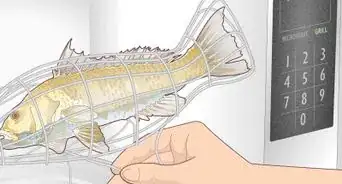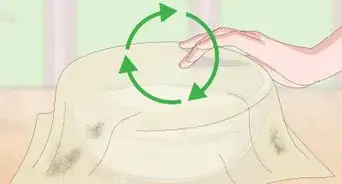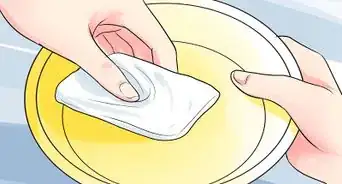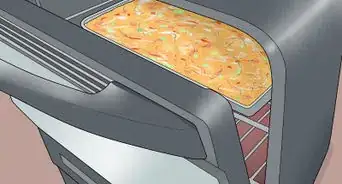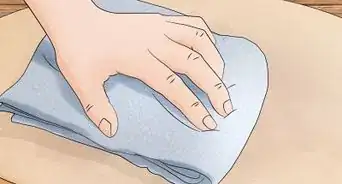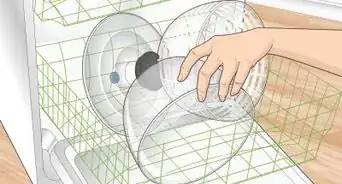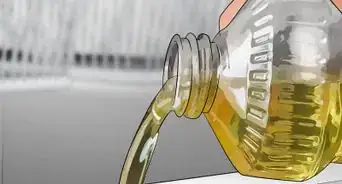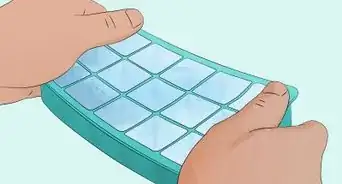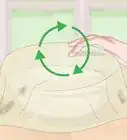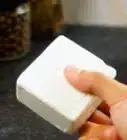This article was co-authored by Filip Boksa. Filip Boksa is the CEO and Founder of King of Maids, a U.S. based home cleaning service that helps clients with cleaning and organization.
There are 7 references cited in this article, which can be found at the bottom of the page.
This article has been viewed 691,017 times.
Stainless steel is an excellent choice for cookware, kitchen appliances, sinks, fixtures, and other items around the house and workplace. The material is durable, has an attractive modern look, and is great for resisting stains and other damage. However, stainless steel isn't bullet-proof, and it can get scratched. But whereas nicks, dents, and deep grooves will require part replacements or help from a professional, you can actually fix minor scratches on your own.
Steps
Buffing Light Scratches
-
1Determine the direction of the grain. The most important part of repairing stainless steel is rubbing in the same direction as the grain. Look very closely at the steel and determine which direction the surface seems to be running in. This is the grain.
- Working against the grain can actually make the scratches worse. That’s why it’s so important to know the direction of the grain before you begin.
- The grain will generally run either from side to side (horizontally), or up and down (vertically).
-
2Choose a non-abrasive compound or cleaner. There are a few compounds and cleaners that can be used to fill and smooth very light and minor scratches on the surface of stainless steel. Products you can try include:[1]
- Bar Keeper's Friend
- Perfect-It Rubbing Compound
- Revere Stainless Steel and Copper Cleaner
- Whitening toothpaste
Advertisement -
3Mix powdered compounds with water. Some compounds and cleaners come in a powdered form, and these must be made into a paste before you can apply them to the steel. Mix a tablespoon (14 g) of powder with a few drops of water. Stir to combine, and add a few more drops of water until you have a smooth paste.
- The consistency you're looking for is that of toothpaste.[2]
-
4Rub the compound into the scratch. Pour a few drops of cleaner onto a clean microfiber cloth. For the paste, spoon about a quarter of the paste onto a cloth. Working in the same direction as the metal’s grain, rub the compound gently into the scratch. Because the compound isn't abrasive, you can rub back and forth over the scratch.
- Continue rubbing, adding more compound as needed, until the scratch has been buffed away.[3]
-
5Wipe off excess compound. Soak a clean microfiber cloth with water. Wring out all the excess so the cloth is barely damp. Wipe the surface of the steel with the cloth to remove excess compound and shine the surface.[4]
-
6Dry and examine the surface. Wipe the surface with a dry microfiber cloth to remove any leftover dampness. Examine the surface of the stainless steel to assess whether the treatment was effective.
- Repeat the buffing process again if the scratch improved but is still slightly visible.
- If the scratch is still quite visible, you may have to take more drastic steps, such as sanding the entire surface.
Sanding Down Deeper Scratches
-
1Choose a sanding product. Slightly deeper scratches on the surface of stainless steel will require more work than light and fine scratches. You have three basic sanding products you can choose from, and they include:
-
2Wet the sanding product. Scratch removal kits come with a lubricant or polishing compound. Apply a few drops of this to the coarsest pad.[7] For sandpaper, soak the 400-grit sandpaper in a bowl full of water for a few minutes. For scouring pads, use a spray bottle filled with water and apply a few spritzes of water to the surface of the pad.[8]
- The liquid or compound acts as a lubricant, and helps the sanding product move over the surface of the metal.
-
3Rub the surface with the coarser pad or paper. Following the grain of the metal, rub the sanding product over the surface of the stainless steel in a single direction. Apply gentle but even pressure to the sandpaper or scour pad. Use long, even strokes.[9]
- It’s important to work in a single direction because rubbing back and forth over the surface can create small abrasions on the metal.
- To ensure you're applying even pressure, wrap the pad or sandpaper around a wooden block before you begin.
- To find the grain, look closely at the metal and see if the surface is running horizontally or vertically. This is the grain of the metal.
-
4Sand the entire surface. Rub the entire surface of the stainless steel in this way. You can't just sand the scratched area, or the sanded section will look visibly different from the rest of the metal. The sanding process is actually re-surfacing the metal, so you have to sand it all.[10]
- Continue sanding until the scratch has been sanded down and is mostly gone.
- Depending on the size of the area you're sanding, this could take 15 minutes or more.
-
5Repeat the sanding process with the finer pad or paper. When you finish sanding with the coarser pad, switch to the finer one. Apply polishing compound, soak the 600-grit sandpaper, or apply water to the gray scouring pad. Sand the entire surface using long, even strokes and gentle, even pressure.[11]
- Continue sanding until the scratch has disappeared.
EXPERT TIPFilip Boksa is the CEO and Founder of King of Maids, a U.S. based home cleaning service that helps clients with cleaning and organization.House Cleaning Professional
 Filip Boksa
Filip Boksa
House Cleaning ProfessionalScratch removal kits can be found at most hardware stores. Stainless steel repair kits are the best way to remove scratches. Just mix 2 tablespoons of the product with 4 or 5 drops of water, then rub it on the scratch with a damp microfiber cloth.
Cleaning and Polishing the Steel
-
1Wipe the surface to remove dust. With a clean microfiber cloth, wipe down the surface that you just sanded. This will remove sanding and metal dust, as well as leftover polishing compound or water.[12]
- Even when you're cleaning, it’s important to rub and buff in the direction of the grain. Look closely at the metal to determine what direction the surfaces runs in, and make sure you rub and clean in that same direction.
-
2Clean the entire surface with vinegar. Transfer some vinegar to a spray bottle. Spray the surface of the metal with several sprays of vinegar. Use a clean microfiber cloth to wipe the metal.
- The vinegar will clean the surface of the metal and remove all traces of other compounds and cleaners.
- Do not use bleach, oven cleaner, abrasive cleaners, or abrasive pads when cleaning stainless steel.[13]
-
3Polish the steel. When the stainless steel is clean and dry, apply a few drops of oil to a clean microfiber cloth. You can use mineral oil, vegetable oil, or even olive oil. Rub the cloth against the steel, in the direction of the grain, to polish the metal.[14]
- Add more oil as necessary. Continue rubbing until the entire surface has been polished.
Community Q&A
-
QuestionHow do you get scratches out of stainless steel sinks?
 wikiHow Staff EditorThis answer was written by one of our trained team of researchers who validated it for accuracy and comprehensiveness.
wikiHow Staff EditorThis answer was written by one of our trained team of researchers who validated it for accuracy and comprehensiveness.
Staff Answer wikiHow Staff EditorStaff AnswerThere are various methods available to you when attempting to remove scratches from stainless steel sinks. You can try cleaning, using a commercial scratch remover or buffing the scratches. Each of these methods is detailed here: How to Get Scratches out of a Stainless Steel Sink.
wikiHow Staff EditorStaff AnswerThere are various methods available to you when attempting to remove scratches from stainless steel sinks. You can try cleaning, using a commercial scratch remover or buffing the scratches. Each of these methods is detailed here: How to Get Scratches out of a Stainless Steel Sink. -
QuestionCan you remove scratches from stainless steel?
 wikiHow Staff EditorThis answer was written by one of our trained team of researchers who validated it for accuracy and comprehensiveness.
wikiHow Staff EditorThis answer was written by one of our trained team of researchers who validated it for accuracy and comprehensiveness.
Staff Answer wikiHow Staff EditorStaff AnswerProvided the scratches are minor and not excessive, it is possible to remove scratches from stainless steel. This can be done by cleaning, using a commercial scratch remover, buffing, sanding down (for deeper scratches) and polishing. Each of these methods is detailed in the article above.
wikiHow Staff EditorStaff AnswerProvided the scratches are minor and not excessive, it is possible to remove scratches from stainless steel. This can be done by cleaning, using a commercial scratch remover, buffing, sanding down (for deeper scratches) and polishing. Each of these methods is detailed in the article above. -
QuestionHow do you get scratches out of brushed stainless steel?
 wikiHow Staff EditorThis answer was written by one of our trained team of researchers who validated it for accuracy and comprehensiveness.
wikiHow Staff EditorThis answer was written by one of our trained team of researchers who validated it for accuracy and comprehensiveness.
Staff Answer wikiHow Staff EditorStaff AnswerThe same methods suggested in the article for trying to remove scratches from stainless steel can be applied to brushed stainless steel as well: Cleaning, buffing and sanding. For cleaning, you can try a metal polish after cleaning before buffing or sanding, as this may be enough to repair shallow scratches. Remember too, that stainless steel will age and look worn over time; some of the scratching is part of its “patina” and is something many people learn to live with.
wikiHow Staff EditorStaff AnswerThe same methods suggested in the article for trying to remove scratches from stainless steel can be applied to brushed stainless steel as well: Cleaning, buffing and sanding. For cleaning, you can try a metal polish after cleaning before buffing or sanding, as this may be enough to repair shallow scratches. Remember too, that stainless steel will age and look worn over time; some of the scratching is part of its “patina” and is something many people learn to live with.
Things You'll Need
- Non-abrasive compound
- Water
- Microfiber cloths
- Sandpaper
- Abrasive pads
- Spray bottle
- Vinegar
- Oil
References
- ↑ http://www.myhousecleaningbiz.com/public/Removing-Scratches-from-Stainless-Steel-Appliances-400.cfm
- ↑ https://household-tips.thefuntimesguide.com/stainless-steel-cleaners/
- ↑ https://www.bobvila.com/articles/how-to-remove-scratches-from-stainless-steel/#.WL92FX9vsfI
- ↑ https://www.bobvila.com/articles/how-to-remove-scratches-from-stainless-steel/#.WL92FX9vsfI
- ↑ https://www.youtube.com/watch?v=FOmUran35dE
- ↑ https://household-tips.thefuntimesguide.com/stainless-steel-cleaners/
- ↑ https://www.bobvila.com/articles/how-to-remove-scratches-from-stainless-steel/#.WL92FX9vsfI
- ↑ http://www.today.com/home/how-can-i-remove-scratches-stainless-steel-appliances-answers-your-t75296
- ↑ https://www.youtube.com/watch?v=FOmUran35dE
- ↑ http://www.today.com/home/how-can-i-remove-scratches-stainless-steel-appliances-answers-your-t75296
- ↑ https://www.bobvila.com/articles/how-to-remove-scratches-from-stainless-steel/#.WL92FX9vsfI
- ↑ https://www.youtube.com/watch?v=FOmUran35dE
- ↑ https://www.bobvila.com/articles/how-to-clean-stainless-steel/#.WMBzrH9vsfI
- ↑ http://www.thekitchn.com/how-to-clean-stainless-steel-appliances-with-vinegar-and-oil-cleaning-lessons-from-the-kitchn-205232
About This Article
To repair minor scratches on stainless steel, buff them out using a microfiber cloth and a non-abrasive cleaner like rubbing compound or toothpaste. For deeper scratches, wet a piece of coarse-grit sandpaper and rub it over the scratch, going in the direction of the grain. Then, repeat with a piece of fine-grit sandpaper until the scratch is no longer visible. To learn how to clean and polish stainless steel after you get scratches out, scroll down!














